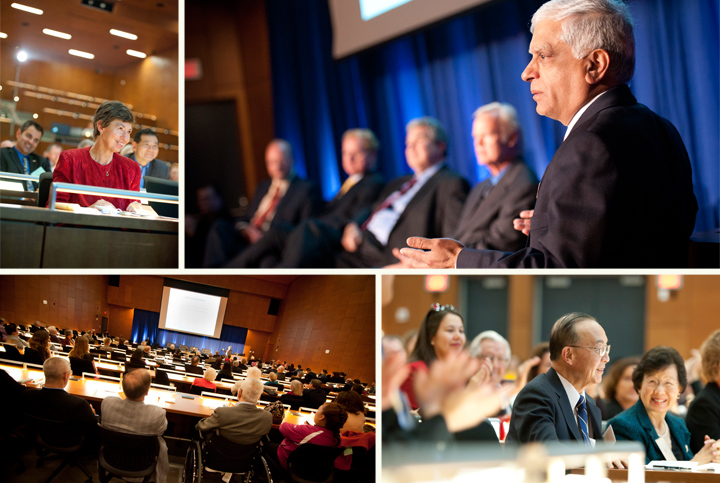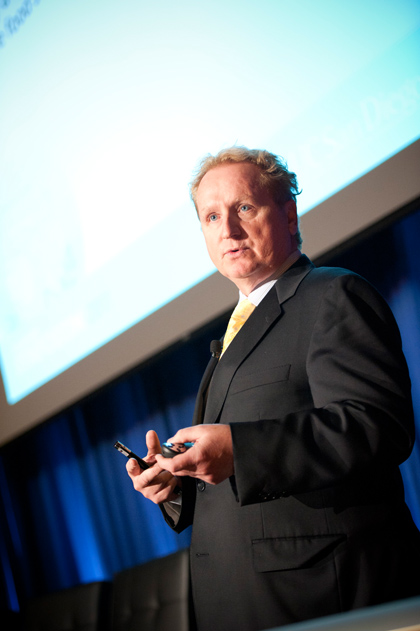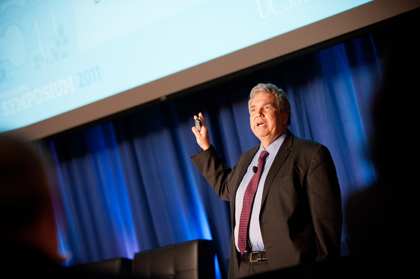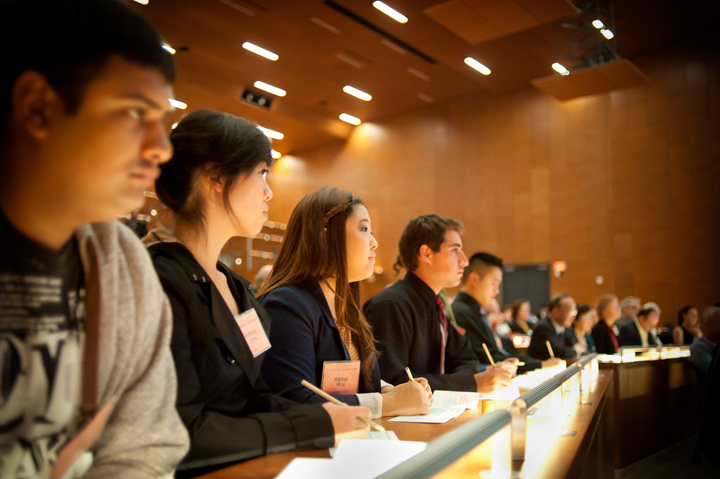
By:
- Paul K. Mueller
Published Date
By:
- Paul K. Mueller
Share This:
Campus Leaders Describe Plans to 'Flash Forward from 50' in Research and Discovery

Photos by Erik Jepsen/UC San Diego Publications
As the campus looks beyond last year's 50th anniversary celebrations, university leaders are developing a new long-term vision for the decades ahead. The central idea behind that vision is a familiar one: "We will build on faculty collaboration across disciplines to produce transformative research with societal impact."
The Founders' Symposium, held on Nov. 17 in the new Medical Education and Telemedicine Learning Building to help commemorate the university's 51st anniversary, allowed a crowd of more than 200 to see, as the program promised, "a sneak preview of UC San Diego's new directions in research and discovery." Three deans and an associate vice chancellor for research helped provide that promising preview.
After a musical prelude of "A Hundred Ghosts," performed by Chris Warren on laptop and strings and Ariana Lamon-Anderson on bass clarinet, Chancellor Marye Anne Fox welcomed the attendants. "Innovation is central to who we are," she said. "The desire to explore, create, and achieve is a common bond."
Suresh Subramani, executive vice chancellor for Academic Affairs, spoke of the imperative need to maintain the quality of the faculty despite the challenges of decreasing state funding. He also emphasized the growing importance of a practice that will shape the discoveries of the 21st century, a practice that is already well-established at UC San Diego: interdisciplinary research.

Helping to make that point, two deans then delivered a partnered presentation titled "Quantitative Biology: The Convergence of Physical and Biological Sciences and the Future." Steve Kay, dean of the Division of Biological Sciences, and Mark Thiemens, dean of the Division of Physical Sciences, described the blurring between once-discrete sciences.
"Will biology become physics, as chemistry did in the 20th century?" asked Kay. In trying to define the "New Biology," he predicted that three avenues of research will emerge in the "sequencing era:" systems biology (which gene networks define life?); synthetic biology (can we synthesize life? Can we build things with genes and proteins?); and quantitative biology (what fundamental equations define biology?).
A deeper understanding of biological systems, he said, will lead to biology-based solutions to societal problems in health, energy, food and the environment. That deeper understanding will not be possible without interdisciplinary work with mathematics, computer science, engineering, and the physical and chemical sciences.
One of the discoveries made by Thiemens, Kay's partner in this part of the symposium, serendipitously illustrated the point. The "mass-independent isotope effect" which the chemist discovered has helped scientists understand aspects of chemical physics, climate change, greenhouse gases, and the formation of the solar system.
The scientific foundations of the 19th-century Industrial Revolution, Thiemens said, were thermodynamics and physical chemistry, symbolized by the steam engine. The foundations of the 20th century -- the Information Revolution -- are quantum mechanics and information theory, symbolized by the iPhone. The foundation of the 21st century -- the Biological Revolution -- is quantitative biology, or "the design or manipulation of biological organisms for useful purposes," including biofuels, bioremediation, personalized medicine and rational drug design.

The concept of design was also at the heart of the next presentation, "The Design Initiative and Policy Labs" by Peter Cowhey, dean of the School of International Relations and Pacific Studies. "What is design?" he asked, then defined it as both a way of thinking and as a tool to be used for solving problems. The more we learn in interdisciplinary ways, he said, the more we understand the need for re-design -- re-thinking not only products but also entire cities and whole systems. His design initiative would "collect faculty around problems, not disciplines," bring design into the classroom, and reach out to industry and the community for new ideas and technology. The policy labs he advocated would replace theory and ideology with evidence gathered from the field. Using global poverty and diseases as examples, he showed that analytical tools can point to surprising solutions. Paying girls to stay in school, for example, reduces the spread of AIDS better than traditional warnings.
Different kinds of surprising solutions were described by George Tynan, associate vice chancellor for research, in his presentation, "Advanced Energy Technology: From the Keeling Curve to Climate Change Solutions." Energy is in the university's DNA, he said, and he quoted Roger Revelle: "The discovery of ways to use less expensive forms of energy than human muscles made it possible for men to be free."
UC San Diego's Advanced Energy Initiative is necessary, he said, to help us maintain our freedoms, especially as the world population will soon outstrip current oil-based energy supplies. The correlation of quality of life and access to energy across the globe presents us with formidable challenges -- especially because fossil fuels account for more than 80 percent of our energy use. The impact on the planet's climate, the "vastly unequal resource access," and energy-security issues make it clear, Tynan said, that a "profound energy revolution is needed."

The university can help contribute to that revolution by finding appropriate and clean energy for the poorer parts of the world; developing carbon-free electricity; using sustainable transportation; weakening the correlation between energy and quality of life; and using data-driven evaluations of the impact of technologies.
Numerous areas of campus -- and residents of the San Diego region -- are engaged in advanced energy research, said Tynan, exploring the potential of nuclear fusion, photovoltaic systems, algae biofuels, cellulosic fuels, wind turbines, and other alternatives.
Tynan summarized not only his own presentation, but also the broader message of the symposium, when he observed that the research of the next decades is "worthy of the legacy we have inherited, and its achievement should be part of the legacy we leave the class of 2060."
Share This:
You May Also Like
Stay in the Know
Keep up with all the latest from UC San Diego. Subscribe to the newsletter today.


